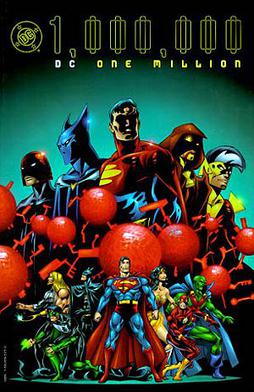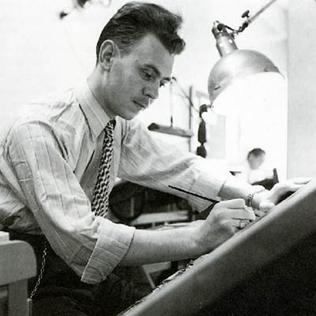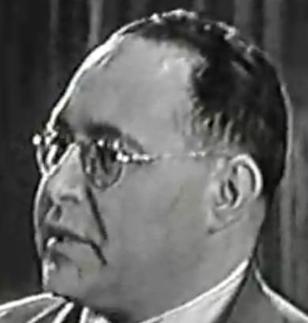Related Research Articles
The Daily Planet is a fictional newspaper appearing in American comic books published by DC Comics, commonly in association with Superman. The newspaper was first mentioned in Action Comics #9 - Underworld Politics, War on Crime. The Daily Planet building's distinguishing feature is the enormous globe that sits on top of the building.

Bizarro is a supervillain or anti-hero appearing in American comic books published by DC Comics. The character was created by writer Otto Binder and artist George Papp as a "mirror image" of Superman, and first appeared in Superboy #68 (1958). Debuting in the Silver Age of Comic Books, the character has often been portrayed as an antagonist to Superman, though on occasion he also takes on an antihero role.

Jimmy Olsen is a fictional character appearing in American comic books published by DC Comics. Olsen is most often portrayed as a young photojournalist working for the Daily Planet. He is close friends with Lois Lane and Clark Kent, and has a good working relationship with his boss Perry White. Olsen looks up to his coworkers as role models and parent figures. From 1954 to 1982, Olsen appeared in 222 issues of the comic series Superman's Pal Jimmy Olsen and Superman Family, in addition to the main Superman titles.

Guardian are DC Comics superheroes introduced in April 1942 by writer/artist Joe Simon and artist Jack Kirby.

Superman's Girl Friend, Lois Lane is an American comic book series published monthly by DC Comics. The series focusing on the adventures of Lois Lane began publication with a March/April 1958 cover date and ended its run in September/October 1974, with 137 regular issues and two 80-page Annuals. Following the similar themed Superman's Pal Jimmy Olsen, Superman's Girl Friend Lois Lane was the second comic series based on a Superman supporting character.

"DC One Million" is a comic book crossover storyline which ran through an eponymous weekly miniseries and through special issues of almost all of the "DCU" titles published by DC Comics in November 1998. It featured a vision of the DC Universe in the 853rd century, chosen because that is the century in which DC would have published issue #1,000,000 of Action Comics if it had maintained a regular monthly publishing schedule. The miniseries was written by Grant Morrison and drawn by Val Semeiks.

"Infinite Crisis" is a 2005–2006 comic book storyline published by DC Comics, consisting of an eponymous, seven-issue comic book limited series written by Geoff Johns and illustrated by Phil Jimenez, George Pérez, Ivan Reis, and Jerry Ordway, and a number of tie-in books. The main miniseries debuted in October 2005, and each issue was released with two variant covers: one by Pérez and one by Jim Lee and Sandra Hope.

Kurt Schaffenberger was an American comics artist. He was best known for his work on Captain Marvel and the Marvel Family during both the Golden Age and Bronze Age of comics, as well as his work on the title Superman's Girl Friend, Lois Lane during the 1950s and 1960s. Schaffenberger used the alias "Lou Wahl" on certain comics, when he was moonlighting from his main job of drawing Lois Lane at DC Comics.

The Superman Family is an American comic book series published by DC Comics from 1974 to 1982 featuring supporting characters in the Superman comics. The term "Superman Family" is often used to refer to the extended cast of characters of comics books associated with Superman. A similarly titled series, Superman Family Adventures, was published in 2012.

Edward Nelson Bridwell was a writer for Mad magazine and various comic books published by DC Comics. One of the writers for the Batman comic strip and Super Friends, he also wrote The Inferior Five, among other comics. He has been called "DC's self-appointed continuity cop."

The American comic book character Superman, created in 1938, has appeared in many types of media since the 1940s. Superman has appeared in radio, television, movies, and video games each on multiple occasions, and his name, symbol, and image have appeared on products and merchandise.
Titano the Super-Ape is a supervillain who appears in American comic books published by DC Comics, primarily as a foe of Superman. The character is a small chimpanzee named Toto who was sent into space for test flight, until an exposure of combined rays have made him grow to gigantic size and gave him Kryptonite-like powers. As a "Super-Ape", Titano rampaged through Metropolis several times in Superman and Superman's Pal Jimmy Olsen during the Silver Age, and also appeared in some "Tales of the Bizarro World" stories in Adventure Comics. After a poorly-received 1978 appearance, Titano was not used again in the comic.
The Superman dynasty, an extension of the House of El, is a lineage of DC Comics superheroes. The term is used for the descendants of Kal-El, the original Superman, who continue to uphold his legacy of heroism well into the 853rd century, as depicted in the DC One Million crossover. Repeated references to members of the Superman dynasty as Superman's "descendants" and at least one reference to them as the "blood of his blood" would seem to indicate that they are, in fact, the biological descendants of Superman in some fashion.

James Winslow "Win" Mortimer was a Canadian comic book and comic strip artist best known as one of the major illustrators of the DC Comics superhero Superman. He additionally drew for Marvel Comics, Gold Key Comics, and other publishers.

The New Adventures of Superman is a series of six-minute animated Superman adventures produced by Filmation that were broadcast Saturday mornings on CBS from September 10, 1966, to September 5, 1970. The 68 segments appeared as part of three different programs during that time, packaged with similar shorts featuring The Adventures of Superboy and other DC Comics superheroes.
The Superman/Aquaman Hour of Adventure is a Saturday morning Filmation animated series that aired on CBS from 1967 to 1968. Premiering on September 9, 1967, this 60-minute program included a series of six-minute adventures featuring various DC Comics superheroes.
Tom Peyer is an American comic book creator and editor. He is known for his 1999 revisioning of Golden Age super-hero Hourman, as well as his work on the Legion of Super-Heroes in the 1990s. An editor at DC Comics/Vertigo from 1987 to 1993, he served as assistant editor on Neil Gaiman's Sandman. Peyer has also worked for Marvel Comics, Wildstorm, and Bongo Comics. With John Layman, he wrote the 2007–2009 Tek Jansen comic book, based on the Stephen Colbert character.

Neal Adams was a comic artist and creator who worked on a large number of comic books and characters, particularly for DC Comics and Marvel Comics, and even creating his own company, Continuity Comics

Leo Dorfman was an American writer of comic books throughout the Silver Age. Although the majority of his work was for DC Comics, he also wrote for Dell Comics and Gold Key Comics.
References
- ↑ Wells, John (2015). American Comic Book Chronicles: 1960-64. TwoMorrows Publishing. p. 23. ISBN 978-1605490458.